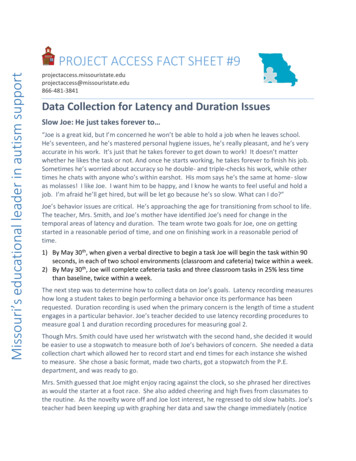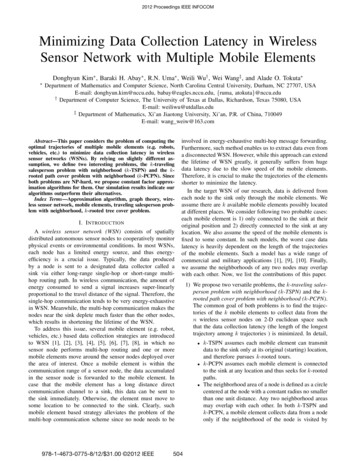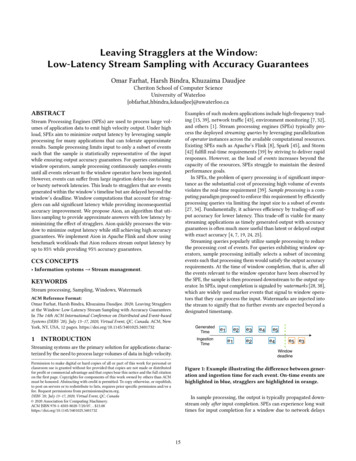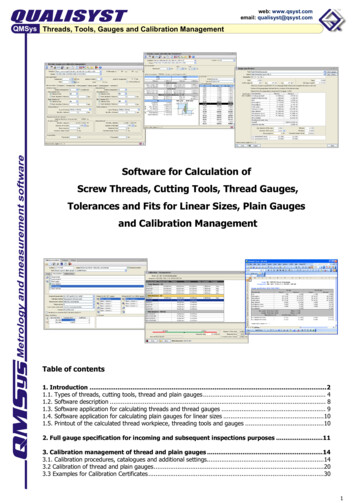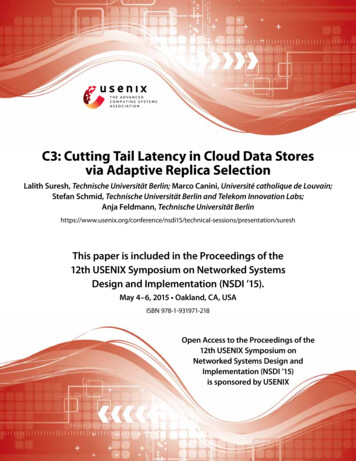
Transcription
C3: Cutting Tail Latency in Cloud Data Storesvia Adaptive Replica SelectionLalith Suresh, Technische Universität Berlin; Marco Canini, Université catholique de Louvain;Stefan Schmid, Technische Universität Berlin and Telekom Innovation Labs;Anja Feldmann, Technische Universität hnical-sessions/presentation/sureshThis paper is included in the Proceedings of the12th USENIX Symposium on Networked SystemsDesign and Implementation (NSDI ’15).May 4–6, 2015 Oakland, CA, USAISBN 978-1-931971-218Open Access to the Proceedings of the12th USENIX Symposium onNetworked Systems Design andImplementation (NSDI ’15)is sponsored by USENIX
C3: Cutting Tail Latency in Cloud Data Stores via Adaptive Replica SelectionLalith Suresh† Marco Canini Stefan Schmid†‡ Anja Feldmann†Berlin Université catholique de Louvain ‡ Telekom Innovation Labs† TUAbstractAchieving predictable performance is critical formany distributed applications, yet difficult to achieve dueto many factors that skew the tail of the latency distribution even in well-provisioned systems. In this paper, wepresent the fundamental challenges involved in designing a replica selection scheme that is robust in the faceof performance fluctuations across servers. We illustratethese challenges through performance evaluations of theCassandra distributed database on Amazon EC2. Wethen present the design and implementation of an adaptive replica selection mechanism, C3, that is robust toperformance variability in the environment. We demonstrate C3’s effectiveness in reducing the latency tail andimproving throughput through extensive evaluations onAmazon EC2 and through simulations. Our results showthat C3 significantly improves the latencies along themean, median, and tail (up to 3 times improvement at the99.9th percentile) and provides higher system throughput.1IntroductionThe interactive nature of modern web applications necessitates low and predictable latencies because peoplenaturally prefer fluid response times [20], whereas degraded user experience directly impacts revenue [11,43].However, it is challenging to deliver consistent low latency — in particular, to keep the tail of the latency distribution low [16, 23, 48]. Since interactive web applications are typically structured as multi-tiered, large-scaledistributed systems, even serving a single end-user request (e.g., to return a web page) may involve contactingtens or hundreds of servers [17, 23]. Significant delays atany of these servers inflate the latency observed by endusers. Furthermore, even temporary latency spikes fromindividual nodes may ultimately dominate end-to-end latencies [2]. Finally, the increasing adoption of commer-USENIX Associationcial clouds to deliver applications further exacerbates theresponse time unpredictability since, in these environments, applications almost unavoidably experience performance interference due to contention for shared resources (like CPU, memory, and I/O) [26, 50, 52].Several studies [16, 23, 50] indicate that latency distributions in Internet-scale systems exhibit long-tail behaviors. That is, the 99.9th percentile latency can be morethan an order of magnitude higher than the median latency. Recent efforts [2, 16, 19, 23, 36, 44, 53] have thusproposed approaches to reduce tail latencies and lowerthe impact of skewed performance. These approachesrely on standard techniques including giving preferentialresource allocations or guarantees, reissuing requests,trading off completeness for latency, and creating performance models to predict stragglers in the system.A recurring pattern to reducing tail latency is to exploit the redundancy built into each tier of the application architecture. In this paper, we show that the problem of replica selection — wherein a client node has tomake a choice about selecting one out of multiple replicaservers to serve a request — is a first-order concern inthis context. Interestingly, we find that the impact of thereplica selection algorithm has often been overlooked.We argue that layering approaches like request duplication and reissues atop a poorly performing replica selection algorithm should be cause for concern. For example,reissuing requests but selecting poorly-performing nodesto process them increases system utilization [48] in exchange for limited benefits.As we show in Section 2, the replica selection strategy has a direct effect on the tail of the latency distribution. This is particularly so in the context of data storesthat rely on replication and partitioning for scalability,such as key-value stores. The performance of these systems is influenced by many sources of variability [16,28]12th USENIX Symposium on Networked Systems Design and Implementation (NSDI ’15) 513
Cassandraand running such systems in cloud environments, whereutilization should be high and environmental uncertaintyis a fact of life, further aggravates performance fluctuations [26].Replica selection can compensate for these conditions by preferring faster replica servers whenever possible. However, this is made challenging by the factthat servers exhibit performance fluctuations over time.Hence, replica selection needs to quickly adapt to changing system dynamics. On the other hand, any reactivescheme in this context must avoid entering pathological behaviors that lead to load imbalance among nodesand oscillating instabilities. In addition, replica selectionshould not be computationally costly, nor require significant coordination overheads.In this paper, we present C3, an adaptive replica selection mechanism that is robust in the face of fluctuations in system performance. At the core of C3’s design,two key concepts allow it to reduce tail latencies andhence improve performance predictability. First, usingsimple and inexpensive feedback from servers, clientsmake use of a replica ranking function to prefer fasterservers and compensate for slower service times, allwhile ensuring that the system does not enter herd behaviors or load-oscillations. Second, in C3, clients implement a distributed rate control mechanism to ensurethat, even at high fan-ins, clients do not overwhelm individual servers. The combination of these mechanismsenable C3 to reduce queuing delays at servers while thesystem remains reactive to variations in service times.Our study applies to any low-latency data storewherein replica diversity is available, such as a key-valuestore. We hence base our study on the widely-used [15]Cassandra distributed database [5], which is designed tostore and serve larger-than-memory datasets. Cassandrapowers a variety of applications at large web sites such asNetflix and eBay [6]. Compared to other related systems(Table 1), Cassandra implements a more sophisticatedload-based replica selection mechanism as well, and isthus a better reference point for our study. However, C3is applicable to other systems and environments that needto exploit replica diversity in the face of performancevariability, such as a typical multi-tiered application orother data stores such as MongoDB or Riak.In summary, we make the following contributions:1. Through performance evaluations on Amazon EC2,we expose the fundamental challenges involved inmanaging tail latencies in the face of service-timevariability (§2).2. We develop an adaptive replica selection mechanism, C3, that reduces the latency tail in the pres-OpenStack SwiftMongoDBRiakDynamic Snitching: considers history ofread latencies and I/O loadRead from a single node andretry in case of failuresOptionally select nearest node by networklatency (does not include CPU or I/O load)Recommendation is to use an externalload balancer such as Nginx [38]Table 1: Replica selection mechanisms in popular NoSQLsolutions. Only Cassandra employs a form of adaptivereplica selection (§2.3).ence of service-time fluctuations in the system. C3does not make use of request reissues, and only relies on minimal and approximate information exchange between clients and servers (§3).3. We implement C3 (§4) in the Cassandra distributeddatabase and evaluate it through experiments conducted on Amazon EC2 (for accuracy) (§5) and simulations (for scale) (§6). We demonstrate that oursolution improves Cassandra’s latency profile alongthe mean, median, and the tail (by up to a factorof 3 at the 99.9th percentile) whilst improving readthroughput by up to 50%.2The Challenge of Replica SelectionIn this section, we first discuss the problem of timevarying performance variability in the context of cloudenvironments. We then underline the need for load-basedreplica selection schemes and the challenges associatedwith designing them.2.1Performance fluctuations are the normServers in cloud environments routinely experience performance fluctuations due to a multitude of reasons. Citing experiences at Google, Dean and Barroso [16] listmany sources of latency variability that occur in practice. Their list includes, but is not limited to, contentionfor shared resources within different parts of and between applications (further discussed in [26]), periodicgarbage collection, maintenance activities (such as logcompaction), and background daemons performing periodic tasks [40]. Recently, an experimental study of response times on Amazon EC2 [50] illustrated that longtails in latency distribution can also be exacerbated byvirtualization. A study [23] of interactive services at Microsoft Bing found that over 30% of analyzed serviceshave 95th percentile of latency 3 times their median latency. Their analysis showed that a major cause for thehigh service performance variability is that latency variesgreatly across machines and time. Lastly, a commonworkflow involves accessing large volumes of data froma data store to serve as inputs for batch jobs on large2514 12th USENIX Symposium on Networked Systems Design and Implementation (NSDI ’15)USENIX Association
ClientRequestQueue1/μ 4msServerAClientClientRequestQueuefor reducing the latency tail, especially since many realistic workloads are skewed in practice and access patternschange over time [9]. Consider the system in Figure 1,with two replica servers that at a particular point in timehave service times of 4 ms and 10 ms respectively. Assume all three clients receive a burst of 4 requests each.Each request needs to be forwarded to a single server.Based on purely local information, if every client selectsa server using the LOR strategy, it will result in eachserver receiving an equal share of requests. This leadsto a maximum latency of 60 ms, whereas an ideal allocation in this case obtains a maximum latency of 32 ms.We note that LOR over time will prefer faster servers, butby virtue of purely relying on local information, it doesnot account for the existence of other clients with potentially bursty workloads and skewed access patterns, anddoes not explicitly adapt to fast-changing service times.Designing distributed, adaptive and stable loadsensitive replica selection techniques is challenging. Ifnot carefully designed, these techniques can suffer from“herd behavior” [32,39]. Herd behavior leads to load oscillations, wherein multiple clients are coaxed to directrequests towards the least-loaded server, degrading theserver’s performance, which subsequently causes clientsto repeat the same procedure with a different server.Indeed, looking at the landscape of popular data stores(Table 1), we find that most systems only implementvery simple schemes that have little or no ability to react quickly to service-time variations nor distribute requests in a load-sensitive fashion. Among the systemswe studied, Cassandra implements a more sophisticatedstrategy called Dynamic Snitching that attempts to makereplica selection decisions informed by histories of readlatencies and I/O loads. However, through performanceanalysis of Cassandra, we find that this technique suffersfrom several weaknesses, which we discuss next.1/μ 4msServerAClientServerBClient1/μ 10msLOR strategy(Max Latency 60ms)ClientServerB1/μ 10msIdeal allocation(Max Latency 32ms)Figure 1: Left: how the least-outstanding requests (LOR)strategy allocates a burst of requests across two serverswhen executed individually by each client. Right: An idealallocation that compensates for higher services time withlower queue lengths.scale computing platforms such as Hadoop, and injecting results back into the data store [45]. These workloadscan introduce latency spikes at the data store and furtherimpact on end-user delays.As part of our study, we spoke with engineers at Spotify and SoundCloud, two companies that use and operate large Cassandra clusters in production. Our discussions further confirmed that all of the above mentionedcauses of performance variability are true pain points.Even in well provisioned clusters, unpredictable eventssuch as garbage collection on individual hosts can leadto latency spikes. Furthermore, Cassandra nodes periodically perform compaction, wherein a node merges multiple SSTables [5, 13] (the on-disk representation of thestored data) to minimize the number of SSTable files tobe consulted per-read, as well as to reclaim space. Thisleads to significantly increased I/O activity.Given the presence of time-varying performance fluctuations, many of which can potentially occur even atsub-second timescales [16], it is important that systemsgracefully adapt to changing conditions. By exploiting server redundancy in the system, we investigate howreplica selection effectively reduces the tail latency.2.2Load-based replica selection is hard2.3Accommodating time-varying performance fluctuationsacross nodes in the system necessitates a replica selection strategy that takes into account the load across different servers in the system. A strategy commonly employed by many systems is the least-outstanding requestsstrategy (LOR). For each request, the client selects theserver to which it has the least number of outstanding requests. This technique is simple to implement and doesnot require global system information, which may notbe available or is difficult to obtain in a scalable fashion. In fact, this is commonly used in load-balancing applications such as Nginx [34] (recommended as a loadbalancer for Riak [38]) or Amazon ELB [3].However, we observe that this technique is not idealDynamic Snitching’s weaknessesCassandra servers organize themselves into a one-hopdistributed hash table. A client can contact any serverfor a read request. This server then acts as a coordinator,and internally fetches the record from the node hostingthe data. Coordinators select the best replica for a givenrequest using Dynamic Snitching. With Dynamic Snitching, every Cassandra server ranks and prefers faster replicas by factoring in read latencies to each of its peers, aswell as I/O load information that each server shares withthe cluster through a gossip protocol.Given that Dynamic Snitching is load-based, we evaluate it to characterize how it manages tail-latencies andif it is subject to entering load-oscillations. Indeed, ourexperiments on Amazon EC2 with a 15-node Cassandra3USENIX Association12th USENIX Symposium on Networked Systems Design and Implementation (NSDI ’15) 515
Requests received per ad pathologies due to Dynamic SnitchingC3 ClientsRequestRS
Jun 10, 2013 · such as garbage collection on individual hosts can lead to latency spikes. Furthermore, Cassandra nodes period-ically perform compaction, wherein a node merges mul-tiple SSTables [5,13] (the on-disk representation of the stored data) to minimize the number of SSTable files to be consulted per-read, as well as to reclaim space. This


